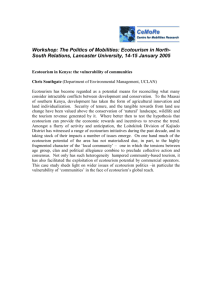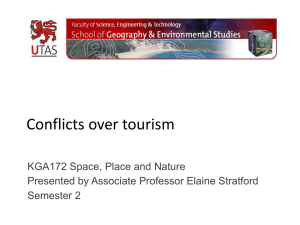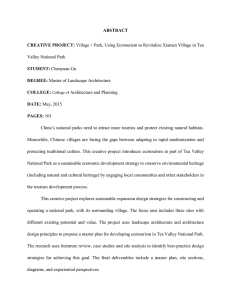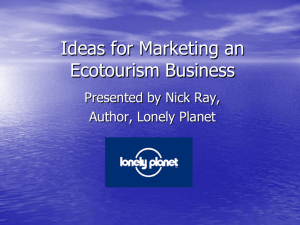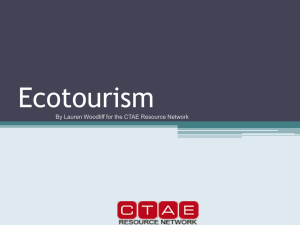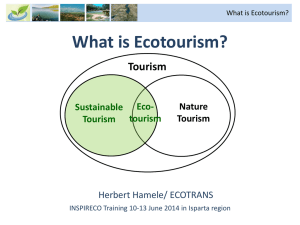The objectives of this presentation are to: (1) describe
advertisement
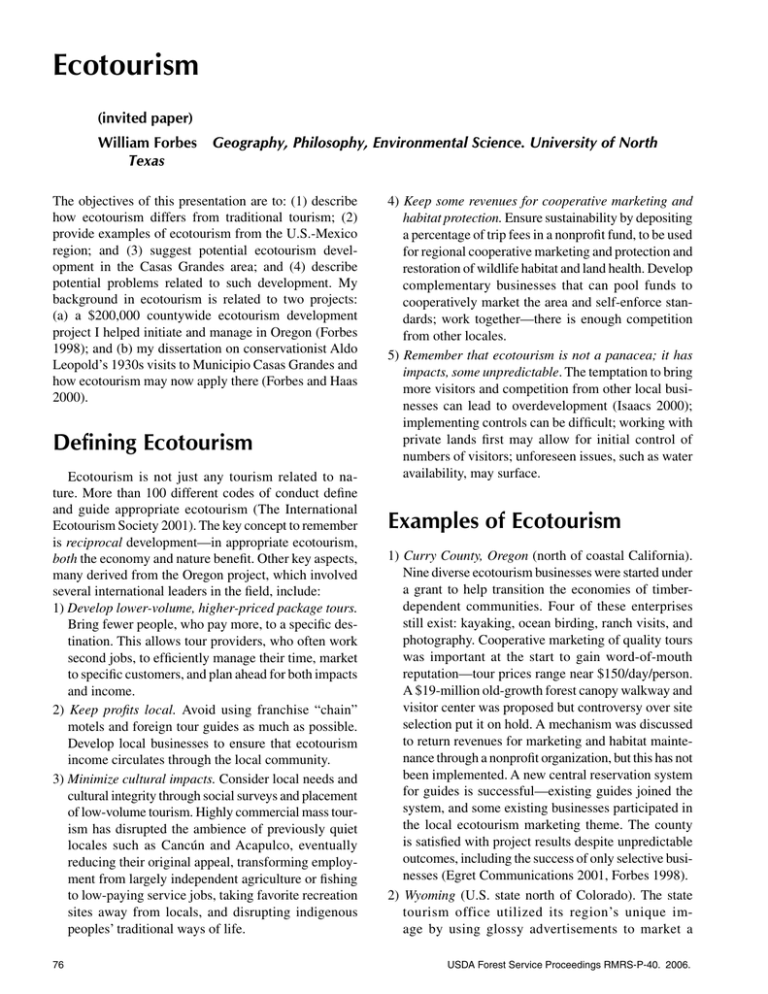
Ecotourism (invited paper) William Forbes Geography, Philosophy, Environmental Science. University of North Texas The objectives of this presentation are to: (1) describe how ecotourism differs from traditional tourism; (2) provide examples of ecotourism from the U.S.-Mexico region; and (3) suggest potential ecotourism development in the Casas Grandes area; and (4) describe potential problems related to such development. My background in ecotourism is related to two projects: (a) a $200,000 countywide ecotourism development project I helped initiate and manage in Oregon (Forbes 1998); and (b) my dissertation on conservationist Aldo Leopold’s 1930s visits to Municipio Casas Grandes and how ecotourism may now apply there (Forbes and Haas 2000). Defining Ecotourism Ecotourism is not just any tourism related to nature. More than 100 different codes of conduct define and guide appropriate ecotourism (The International Ecotourism Society 2001). The key concept to remember is reciprocal development—in appropriate ecotourism, both the economy and nature benefit. Other key aspects, many derived from the Oregon project, which involved several international leaders in the field, include: 1) Develop lower-volume, higher-priced package tours. Bring fewer people, who pay more, to a specific destination. This allows tour providers, who often work second jobs, to efficiently manage their time, market to specific customers, and plan ahead for both impacts and income. 2) Keep profits local. Avoid using franchise “chain” motels and foreign tour guides as much as possible. Develop local businesses to ensure that ecotourism income circulates through the local community. 3) Minimize cultural impacts. Consider local needs and cultural integrity through social surveys and placement of low-volume tourism. Highly commercial mass tourism has disrupted the ambience of previously quiet locales such as Cancún and Acapulco, eventually reducing their original appeal, transforming employment from largely independent agriculture or fishing to low-paying service jobs, taking favorite recreation sites away from locals, and disrupting indigenous peoples’ traditional ways of life. 76 4) Keep some revenues for cooperative marketing and habitat protection. Ensure sustainability by depositing a percentage of trip fees in a nonprofit fund, to be used for regional cooperative marketing and protection and restoration of wildlife habitat and land health. Develop complementary businesses that can pool funds to cooperatively market the area and self-enforce standards; work together—there is enough competition from other locales. 5) Remember that ecotourism is not a panacea; it has impacts, some unpredictable. The temptation to bring more visitors and competition from other local businesses can lead to overdevelopment (Isaacs 2000); implementing controls can be difficult; working with private lands first may allow for initial control of numbers of visitors; unforeseen issues, such as water availability, may surface. Examples of Ecotourism 1) Curry County, Oregon (north of coastal California). Nine diverse ecotourism businesses were started under a grant to help transition the economies of timberdependent communities. Four of these enterprises still exist: kayaking, ocean birding, ranch visits, and photography. Cooperative marketing of quality tours was important at the start to gain word-of-mouth reputation—tour prices range near $150/day/person. A $19-million old-growth forest canopy walkway and visitor center was proposed but controversy over site selection put it on hold. A mechanism was discussed to return revenues for marketing and habitat maintenance through a nonprofit organization, but this has not been implemented. A new central reservation system for guides is successful—existing guides joined the system, and some existing businesses participated in the local ecotourism marketing theme. The county is satisfied with project results despite unpredictable outcomes, including the success of only selective businesses (Egret Communications 2001, Forbes 1998). 2) Wyoming (U.S. state north of Colorado). The state tourism office utilized its region’s unique image by using glossy advertisements to market a USDA Forest Service Proceedings RMRS-P-40. 2006. ranch-tourism program, including high-priced packages, such as $1,500/week/person for a log cabin with private bath and fireplace. Though not all destinations fit the full definition of ecotourism, the program demonstrates the marketability of ranch stays (Egret Communications 2001, Wyoming Dude Ranchers Association 2001, Wyoming Tourist Association 2001). 3) Belize (small nation east of Mexico). Some communities found that remote sites are marketable—in fact, that is part of their appeal—and that good roads are not absolutely necessary to attract travelers. Good cooperation and conservation ethics developed among many local guides and lodges. Several large expanses of coastal mangrove forests were protected partly due to their tourism attraction (Egret Communications 2001). 4) Monarch Reserve, Michoacán, México. Ecotourism helped stop logging of critical monarch butterfly habitat. Locals dependent on the tourism supported forest protection. Some tourists, such as large weekend groups, have negative ecological impacts—many hike without guides, for example, resulting in trash, noise, and some loss of butterflies through vandalism (LaFranchi 2000). 5) San Nicolas Totolapan (near Mexico City). Balam Consultants won several awards for their work with ejidos (community land ownerships in Mexico) in ecotourism development (hiking, mountain biking). They spent a total of 600 hours working with ejiditarios (members of the community-held land) on marketing and public relations; for every hour of business-skills development, they spent four hours working with the ejiditarios on confidence-building. The project protected 5,693 acres (2,304 hectares) that would have otherwise been lost to illegal logging and urban sprawl. The project was mentioned in the September 2001 issue of National Geographic (Mader 2001). 6) La Ruta Sonora (Arizona-Sonora). This Tucson nonprofit organization developed three Arizona (U.S.) to Sonora (Mexico) tours, with desert–sea, river, and heritage themes. They manage a three-person office in Tucson and contract out for vans and local guides as needed. Part of the trip fees (3 percent) goes to habitat conservation. Tours emphasize ecological issues, including water conservation, bird watching, and environmental history at destinations such as the Colorado River Delta (La Ruta Sonora 2001). Potential Ecotourism Development Near Casas Grandes 1) Specialized nature-oriented travelers. Bird watchers may be attracted by unique birds not found in most of the United States, such as the vermillion flycatcher, trogon, and thick-billed parrot. Rather than relying on a single bird species, however, tourist packages will likely need to encompass a variety of birds—grasslands, winter waterfowl, and forest birds—as well as nonbirding attractions such as the area’s unique cultural and historical destinations, including archaeological ruins (Drewien 2000). Conservationists may be attracted to sites such as North America’s largest prairie-dog colony near Janos, remote forests, or Aldo Leopold’s 1930s campsite, where he saw “perfect” land health (Forbes and Haas 2000). Some enjoy participating in research or habitat-restoration projects during their trips. Both groups, bird watchers and conservations, can be targeted through specific nature periodicals and nonprofit organizations’ membership lists. Ecotourism enterprises can save on the costs of placing advertisements and of covering travel writers’ trip expenses by having members write their own articles for submission to appropriate media and by partnering with similar organizations. 2) Paquimé visitors. On the site of these 13th-century ruins, excavated in the 1970s, a million-dollar interpretive museum was opened in the early 1990s. European and Mexican visitation has increased since the ruins’1998 designation as a World Heritage Site. European travelers are generally more adventurous than American travelers and will visit nearby remote sites if supplied with proper information. Opportunities to link heritage and nature tourism are frequently overlooked, such as using exhibits and brochures to market to existing visitors (Steele-Prohaska 1996). A visitor survey could be conducted in partnership with the museum to characterize and target visitors’ hometowns and cities. The Mimbres-Paquimé Connection (2001) is a cross-border tourism partnership based on the similar cultural heritage of northwestern Chihuahua and southwestern New Mexico. 3) Ranch and ejido visitors. Home stays can offer an attractive alternative to hotels and traditional tourism. They may offer more intimate, reliable reservations; local hotels have been known to cancel small-group packages to accommodate overflow visitors from USDA Forest Service Proceedings RMRS-P-40. 2006.77 other functions. Part of the trip fee could go to purchase local ejido school supplies, as a way to acknowledge and meet some of the community’s social needs, as well as to marketing and conservation. Several local ranches are looking for alternative income due to recent drought and low cattle prices. 4) General travelers. Four U.S. cities having populations greater than 500,000 lie within one day’s driving distance of the U.S.–Mexican border: Albuquerque, El Paso, Phoenix, and Tucson. Opportunities exist to attract additional general travelers by arranging package tours, and border parking and pickup (Hatch 1998). Potential Problems With Ecotourism Development Near Casas Grandes 1) Cultural impacts. Local Old-Order Mennonites want to preserve cultural integrity and do not desire frequent contact with tourists (List 2001, Sawatzky 1971). Passing through a Mennonite colony is necessary to reach the largest concentration of prairie dogs near Janos. Local Mormons are not as sensitive to outside contact, having served as guides to sportsmen since the early 1900s, including Teddy Roosevelt, various U.S. senators, and Aldo Leopold (Hatch 1998). Indigenous population is low, although several mountain sites are sacred to Apaches now based in the United States (Goodwin 2000, Villa 1998). 2) Spreading benefits. Competition among hotels in Nuevo Casas Grandes could make cooperative marketing among them difficult. Some ejiditarios may benefit more than others. Mata Ortiz, an ejido town southwest of Casas Grandes, has spread tourism’s benefits throughout the town by training locals in making replica Paquimé pottery; this may provide a model for ecotourism (Smith and MacMillan 1998). 3) Linking with other economic development plans. Major road and hotel development may allow too much access, tax the limits of water supplies, and ruin the appeal of some remote sites. Scale of development is critical (King and Czech 1995). Community leaders should recognize the economic appeal of remote natural sites to tourists, and the sites’ potential for economic development—or overdevelopment. 4) Wildlife impacts. Some charismatic wildlife, including prairie dogs and thick-billed parrots, is thought to be at relatively low risk from visitors, but others, such as the golden eagle, may be at higher risk (List 2001, Snyder et al. 1999, Venegas 2001). These concerns should be incorporated into advance planning. 78 Conclusion Ecotourism offers potential to benefit both the economy and nature, diversifying local incomes while generating reasons and funding to protect habitat, but it needs to be done carefully in areas such as Casas Grandes. Considering site specifics is important in order to take advantage of attractions unique to the area while being sensitive to cultural and biological integrity. Ecotourism initiatives on private land may offer more control over initial unpredictable results. The following references, including websites, offer further assistance and information. References Drewien, R. 1999. Personal communication. Wildlife biologist. Bozeman, MT. Egret Communications. 2001. Belize and Wyoming projects, and Curry County, Oregon, Sustainable Nature-Based Tourism Project. Website: www.egretcommunications. com Forbes, W. 1998. Curry County Sustainable Nature-Based Tourism Project. In, Sustainable Tourism: A Geographical Perspective. Hall, C.M.; Lew, A., eds. London: Addison, Wesley, Longman. Forbes, W.; Haas, T.S. 2000. Leopold’s Legacy in the Rio Gavilan: Revisiting an Altered Mexican Wilderness. Wild Earth. Vol. 10, No. 1. Goodwin, G.; Goodwin, N. 2000. Apache Diaries: A FatherSon Journey. Lincoln: University of Nebraska Press. Hatch, J. 1998. Personal communication. Backcountry guide. Colonia Juarez, Chih. Isaacs, J. C. 2000. The limited potential of ecotourism to contribute to wildlife conservation. The Wildlife Society Bulletin. Spring Issue, p.61-69. Website: www.wildlife. org/publications/wsb2801/8sc_isaac.pdf King, D. A.; Czech, B. 1995. Ecotourism and the Madrean Archipelago. In, Biodiversity and Management of the Madrean Archipelago: The Sky Islands of Southwestern United States and Northwestern Mexico. Fort Collins, CO.: U.S. Department of Agriculture, Forest Service, General Technical Report RM-264. LaFranchi, H. 2000. Butterflies Falling on Cedars: Monarchs’ Winter Homes in Mexico Threatened. Christian Science Monitor. Website: abcnews.go.com/sections/science/ DailyNews/butterflies000203.html La Ruta de Sonora. 2001. Homepage. Tucson, AZ. Website: www.laruta.org/ List, R. 2001. Personal communication. Wildlife biologist. Mexico, D.F. Mader, R. 2001. Ecotourism in Latin America (with link to Balam Consultants). Website: www.planeta.com. Mimbres-Paquimé Connection. 2001. Southwest Adventure Tours. Silver City, NM: Western New Mexico University. Website: www.wnmu.edu/paquime/main.html Sawatzky, H.L. 1971. They sought a country: Mennonite colonization in Mexico. Berkeley: University of California Press. USDA Forest Service Proceedings RMRS-P-40. 2006. Smith, S. S.; MacCallum, S.H. 1998. Portraits of Clay: Potters of Mata Ortiz. Tucson: University of Arizona Press. Snyder, N. F. R.; Enkerlin-Hoeflich, E.C.; Cruz-Nieto, M.A.. 1999. Thick-billed Parrot (Rhynchopsitta pachyrhyncha). In, The Birds of North America, No. 406. (A. Poole and F. Gill, eds.). Philadelphia: The Birds of North America, Inc. Steele-Prohaska, S. 1996. Ecotourism and Cultural Heritage Tourism: Forging Stronger Links. In, The Ecotourism Equation: Measuring the Impacts, Yale School of Forestry and Environmental Studies Bulletin Series, No. 99, p. 278283. New Haven, CT: Yale University. The International Ecotourism Society (TIES). 2001. Ecotourism Explorer. Burlington, VT. TIES website: www. ecotourism.org Venegas, D. 2001. Personal communication. Wildlife biologist. Chihuahua, Chih. Villa, N. W. 1998. Personal communication. Apache historian. Colonia Juarez, Chih. Wyoming Dude Ranchers Association. 2001. List of guest ranches. Website: www.wyomingdra.com Wyoming Tourism Association. 2001. Online Reservations— nonprofit reservation system set up by state. Website: www. wyomingtourism.org. USDA Forest Service Proceedings RMRS-P-40. 2006.79 Ecoturismo (resumen) William Forbes Universidad del Norte de Texas Los objetivos de esta presentación son: (1) describir cómo difiere el ecoturismo del turismo tradicional, (2) proporcionar ejemplos de ecoturismo de la región México-Estados Unidos, (3) sugerir el desarrollo de ecoturismo potencial en el área de Casas Grandes y (4), describir los problemas potenciales en relación a dicho desarrollo. Mis antecedentes en ecoturismo se relacionan a dos proyectos: (a) un proyecto de desarrollo de ecoturismo a nivel municipal de $200,000.00USD que ayudé a iniciar y administrar en Oregon (Forbes 1998); y (b) mi disertación sobre las visitas del conservacionista Aldo Leopold al municipio de Casas Grandes y cómo puede aplicarse el ecoturismo ahí ahora (Forbes and Haas 2000). Definción de Ecoturismo El ecoturismo no es sólo cualquier turismo relacionado con la naturaleza. El concepto clave es el desarrollo recíproco: en el ecoturismo apropiado tanto la economía como la naturaleza se benefician (The International Ecotourism Society 2001). Otros aspectos clave son: 1. Desarrollar paquetes de recorridos de menor volumen y mayor precio. Esto facilita a los proveedores del servicio a hacer un manejo más eficiente de su propio tiempo, servir a clientes específicos y prepararse para impactos e ingresos. 2. Mantener las ganancias a nivel local. Evita usar franquicias, cadenas de moteles y guías extranjeros. 3. Minimizar los impactos culturales. Toma en consideración las necesidades locales y la integridad cultural a través de encuestas sociales y la colocación de turismo de bajo volumen. De otra forma se reduce su atractivo original y se perturba el estilo de vida y de trabajo tradicional de la gente del lugar. 4. Separar algunas ganancias para mercadotecnia cooperativa y protección del hábitat. Asegura la sustentabilidad depositando un porcentaje de las ganancias en un fondo a utilizarse para mercadotecnia cooperativa y protección del hábitat natural y de la salud de la tierra. 5. Recordar que el ecoturismo no es una panacea; tiene impactos, algunos impredecibles. La competencia de otros negocios puede llevar a un desarrollo excesivo 80 (Isaacs 2000). Puede ser difícil implementar controles y pueden surgir asuntos no previstos, como disponibilidad de agua. Algunos Ejemplos de Ecoturismo 1. Curry County, Oregon. Se crearon nueve empresas diferentes de ecoturismo para ayudar a la transición económica de las comunidades leñadoras. Se pospuso su desarrollo y aún no se implementa un mecanismo para reinvertir ganancias. El municipio está satisfecho con los resultados del proyecto, a pesar de los resultados impredecibles (Egret Communications 2001; Forbes 1998). 2. Wyoming. La oficina estatal de turismo promovió un programa de turismo en ranchos. No todos los destinos cumplen con la definición de ecoturismo, pero el programa demuestra la factibilidad de las visitas a ranchos (Egret Communications 2001; Wyoming Dude Ranchers Association 2001; Wyoming Tourist Association 2001). 3. Belice. Se desarrolló buena cooperación y ética de conservación entre las comunidades que explotan los sitios remotos para ecoturismo. A raíz de su atractivo turístico, se protegieron grandes extensiones de manglares costeros (Egret Communications 2001). 4. Reserva Monarca en Michoacán, México. El ecoturismo ayudó a detener la tala del hábitat esencial de la mariposa monarca. Sin embargo, los grupos grandes de turistas tienen un impacto negativo sobre todo cuando no traen a un guía local (LaFranchi 2000). 5. San Nicolás Totolapan (México). Balam Consultants trabajó con ejidatarios para desarrollar mercadotecnia y relaciones públicas. Se protegieron 2,304 hectáreas que de otra forma se hubieran perdido (Mader 2001). 6. La Ruta Sonora. Esta organización no lucrativa desarrolló tres recorridos de Arizona a Sonora. 3% de la tarifa se usa para conservación del hábitat y los recorridos enfatizan asuntos ecológicos (La Ruta Sonora 2001). USDA Forest Service Proceedings RMRS-P-40. 2006. Desarrollo Potencial de Ecoturismo Cerca de Casas Grandes 1. Viajeros especializados con orientación hacia la naturaleza. Los observadores de aves podrían ser atraídos por pájaros no encontrados en muchos lugares de los Estados Unidos. La mercadotecnia podría combinar la observación de aves de pastizal, aves acuáticas de invierno y aves de bosque y podría mezclar con atractivos no relacionados con los recursos bióticos como la singular historia cultural y las ruinas arqueológicas del área (Drewien 2000). Los conservacionistas podrían ser llevados a sitios atractivos como los lugares de campamento de Aldo Leopold (Forbes and Haas 2000), y otros podrían disfrutar su participación en proyectos de investigación o restauración de hábitats durante sus recorridos. 2. Visitantes a Paquimé. Los visitantes europeos y mexicanos han aumentado desde que estas ruinas del siglo 13 fueron designadas patrimonio mundial en 1998. Existen oportunidades para ligar el turismo de herencia patrimonial con el turismo naturalista que pueden darse mediante trípticos o mercadeo hacia los visitantes potenciales (Steele-Prohaska 1996). La conexión Mimbres – Paquimé (Mimbres-Paquimé Connection 2001) es un turismo de herencia patrimonial a través de la frontera que une al noroeste de Chihuahua y el suroeste de Nuevo México. 3. Visitantes a ranchos y ejidos. Estas visitas pueden ser más atractivas que los hoteles, porque ofrecen reservaciones más íntimas y confiables. Parte de la tarifa del viaje podría usarse en útiles escolares para el ejido. 4. Viajeros en general. A un día de manejo hay cuatro ciudades de E.U. con poblaciones mayores a 500,000 habitantes para las cuales se pueden diseñar paquetes turísticos atractivos: Albuquerque, El Paso, Phoenix, and Tucson (Hatch 1998). Problemas Potenciales Para el Desarrollo de Ecoturismo Cerca de Casas Grandes 1. Impactos culturales. Los Menonitas locales quieren preservar su integridad cultural y no desean contacto frecuente con los turistas. (Sawatzky 1971; List 2001). Los Mormones de la localidad no son muy comunicativos y solo han servido como guías de deportistas desde el inicio de los 1900s (Hatch 1998). La población indígena es baja, aunque varios sitios montañosos son sagrados para los Apaches, ahora establecidos en los Estados Unidos (Villa 1998; Goodwin 2000). 2. Distribución de los beneficios. La competencia entre los hoteles de Nuevo Casas Grandes podría dificultar una mercadotecnia cooperativa. El ejido Mata Ortiz ha distribuido los beneficios del turismo capacitando al pueblo para hacer réplicas de cerámica Paquimé. (Smith and MacMillan 1998). 3. Enlace con otros planes de desarrollo económico. El desarrollo de la infraestructura podría permitir demasiado acceso, presionar el suministro de agua y arruinar el atractivo de algunos sitios remotos. La escala del desarrollo es crítica (King and Czech 1995). 4. Impactos a la fauna silvestre. El impacto a las especies en riesgo debe incorporarse en la planeación avanzada (Snyder et al. 1999; List 2001; Venegas 2001). Conclusión El ecoturismo ofrece beneficios potenciales tanto a la economía como a la naturaleza, diversificando el ingreso local, mientras se generan razones y fondos para proteger el hábitat. References Drewien, R. 1999. Personal communication. Wildlife biologist. Bozeman, MT. Egret Communications. 2001. Belize and Wyoming projects, and Curry County, Oregon, Sustainable Nature-Based Tourism Project. Website: www.egretcommunications. com Forbes, W. 1998. Curry County Sustainable Nature-Based Tourism Project. In, Sustainable Tourism: A Geographical Perspective. Hall, C.M.; Lew, A., eds. London: Addison, Wesley, Longman. Forbes, W.; Haas, T.S. 2000. Leopold’s Legacy in the Rio Gavilan: Revisiting an Altered Mexican Wilderness. Wild Earth. Vol. 10, No. 1. Goodwin, G.; Goodwin, N. 2000. Apache Diaries: A FatherSon Journey. Lincoln: University of Nebraska Press. Hatch, J. 1998. Personal communication. Backcountry guide. Colonia Juarez, Chih. Isaacs, J. C. 2000. The limited potential of ecotourism to contribute to wildlife conservation. The Wildlife Society Bulletin. Spring Issue, p.61-69. Website: www.wildlife. org/publications/wsb2801/8sc_isaac.pdf King, D. A.; Czech, B. 1995. Ecotourism and the Madrean Archipelago. In, Biodiversity and Management of the Madrean Archipelago: The Sky Islands of Southwestern United States and Northwestern Mexico. Fort Collins, CO.: U.S. Department of Agriculture, Forest Service, General Technical Report RM-264. LaFranchi, H. 2000. Butterflies Falling on Cedars: Monarchs’ Winter Homes in Mexico Threatened. Christian Science USDA Forest Service Proceedings RMRS-P-40. 2006.81 Monitor. Website: abcnews.go.com/sections/science/ DailyNews/butterflies000203.html La Ruta de Sonora. 2001. Homepage. Tucson, AZ. Website: www.laruta.org/ List, R. 2001. Personal communication. Wildlife biologist. Mexico, D.F. Mader, R. 2001. Ecotourism in Latin America (with link to Balam Consultants). Website: www.planeta.com. Mimbres-Paquimé Connection. 2001. Southwest Adventure Tours. Silver City, NM: Western New Mexico University. Website: www.wnmu.edu/paquime/main.html Sawatzky, H.L. 1971. They sought a country: Mennonite colonization in Mexico. Berkeley: University of California Press. Smith, S. S.; MacCallum, S.H. 1998. Portraits of Clay: Potters of Mata Ortiz. Tucson: University of Arizona Press. Snyder, N. F. R.; Enkerlin-Hoeflich, E.C.; Cruz-Nieto, M.A.. 1999. Thick-billed Parrot (Rhynchopsitta pachyrhyncha). In, The Birds of North America, No. 406. (A. Poole and F. Gill, eds.). Philadelphia: The Birds of North America, Inc. Steele-Prohaska, S. 1996. Ecotourism and Cultural Heritage Tourism: Forging Stronger Links. In, The Ecotourism Equation: Measuring the Impacts, Yale School of Forestry and Environmental Studies Bulletin Series, No. 99, p. 278283. New Haven, CT: Yale University. The International Ecotourism Society (TIES). 2001. Ecotourism Explorer. Burlington, VT. TIES website: www. ecotourism.org Venegas, D. 2001. Personal communication. Wildlife biologist. Chihuahua, Chih. Villa, N. W. 1998. Personal communication. Apache historian. Colonia Juarez, Chih. Wyoming Dude Ranchers Association. 2001. List of guest ranches. Website: www.wyomingdra.com Wyoming Tourism Association. 2001. Online Reservations— nonprofit reservation system set up by state. Website: www. wyomingtourism.org. 82 USDA Forest Service Proceedings RMRS-P-40. 2006.

![Ecotourism_revision[1]](http://s2.studylib.net/store/data/005398532_1-116d224f2d342440647524cbb34c0a0a-300x300.png)
